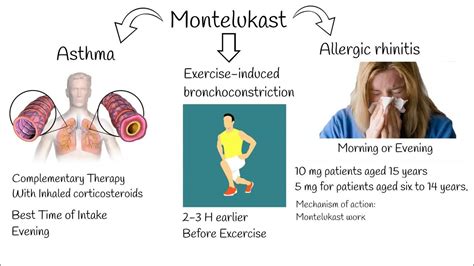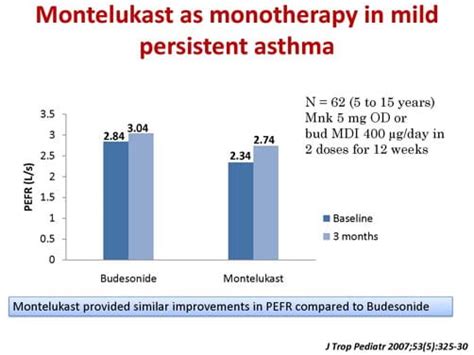Intro
Discover 5 key facts about Montelukast, a leukotriene receptor antagonist, including its uses, benefits, and side effects, for asthma, allergy, and respiratory treatment, and learn how it works as an anti-inflammatory medication.
The importance of understanding medications cannot be overstated, especially when it comes to managing chronic conditions like asthma and allergies. One such medication that has gained significant attention in recent years is Montelukast, a prescription drug used to treat asthma, seasonal allergies, and perennial allergies. For individuals living with these conditions, Montelukast can be a game-changer, offering relief from symptoms and improving quality of life. However, like any medication, it's crucial to delve into its specifics, including how it works, its benefits, potential side effects, and how to use it effectively.
Montelukast belongs to a class of drugs known as leukotriene receptor antagonists, which work by blocking the action of leukotrienes, substances in the body that cause allergy symptoms and asthma. By understanding how Montelukast functions and its role in managing respiratory and allergic conditions, patients can better navigate their treatment plans and make informed decisions about their health. Moreover, recognizing the benefits and potential drawbacks of Montelukast can help individuals and healthcare providers weigh the pros and cons of including this medication in a treatment regimen.
As we explore the world of Montelukast, it becomes clear that this medication offers a unique approach to managing asthma and allergies, distinct from other treatments like corticosteroids and bronchodilators. Its ability to target specific pathways involved in the inflammatory process makes it an attractive option for those seeking to control their symptoms without the side effects associated with other medications. However, the effectiveness of Montelukast can vary among individuals, highlighting the need for personalized medical care and ongoing monitoring to ensure the best possible outcomes.
Introduction to Montelukast

Montelukast is known under several brand names, with Singulair being one of the most recognized. It's available in various forms, including tablets, chewable tablets, and oral granules, making it accessible to a wide range of patients, including children. The versatility in its formulation allows healthcare providers to tailor the treatment to the individual's needs, ensuring compliance and effectiveness.
How Montelukast Works

The mechanism of action of Montelukast involves the blockade of cysteinyl leukotriene receptors, which are found in the lungs and other parts of the body. By blocking these receptors, Montelukast prevents the actions of leukotrienes, which are chemical messengers involved in inflammatory processes. This blockade results in decreased inflammation, mucus production, and airway constriction, thereby alleviating symptoms of asthma and allergies.
Benefits of Using Montelukast
The benefits of Montelukast are multifaceted:
- Improved Asthma Control: By reducing inflammation and airway constriction, Montelukast can help in controlling asthma symptoms, reducing the frequency of exacerbations, and improving lung function.
- Relief from Allergy Symptoms: For individuals with seasonal or perennial allergies, Montelukast can provide relief from symptoms such as sneezing, runny nose, and itchy eyes.
- Convenience: Being an oral medication, Montelukast offers a convenient alternative to inhalers, which can be daunting for some patients, especially children.
- Potential for Reduced Side Effects: Compared to other asthma and allergy medications, Montelukast may have a more favorable side effect profile for some patients, although this can vary.
Potential Side Effects and Considerations

While Montelukast is generally well-tolerated, it's not without potential side effects. Common side effects include:
- Headache
- Dizziness
- Nausea
- Diarrhea
- Abdominal pain
- Fever
- Upper respiratory infection
Rare but more serious side effects can include:
- Neuropsychiatric events (e.g., aggression, anxiety, depression)
- Eosinophilia (an increase in eosinophils, a type of white blood cell)
Steps for Effective Use
To use Montelukast effectively:
- Follow the Prescribed Dosage: Adhere to the dosage and administration instructions provided by your healthcare provider.
- Monitor Your Symptoms: Keep track of your symptoms to assess the effectiveness of the medication and report any changes to your healthcare provider.
- Combine with Other Treatments as Directed: If prescribed, use Montelukast in conjunction with other asthma or allergy medications as part of a comprehensive treatment plan.
- Attend Follow-Up Appointments: Regular check-ins with your healthcare provider are crucial for adjusting your treatment plan as needed and addressing any concerns.
Practical Examples and Statistical Data

Studies and clinical trials have demonstrated the efficacy of Montelukast in managing asthma and allergies. For instance, research has shown that Montelukast can reduce the frequency of asthma exacerbations and improve quality of life for patients with asthma. Additionally, data indicate that Montelukast is effective in alleviating symptoms of seasonal allergies, such as hay fever, in both adults and children.
Conclusion and Future Directions
In conclusion, Montelukast represents a valuable option in the management of asthma and allergies, offering a unique mechanism of action and potential benefits for patients. As with any medication, it's essential to weigh the benefits against the potential risks and to use it under the guidance of a healthcare provider. Ongoing research and clinical trials continue to refine our understanding of Montelukast's role in respiratory and allergic diseases, paving the way for more personalized and effective treatment strategies.
What is Montelukast used for?
+Montelukast is used to treat asthma, seasonal allergies, and perennial allergies by blocking the action of leukotrienes.
How does Montelukast work?
+Montelukast works by blocking cysteinyl leukotriene receptors, which are involved in the inflammatory process, thereby reducing inflammation, mucus production, and airway constriction.
What are the common side effects of Montelukast?
+Common side effects of Montelukast include headache, dizziness, nausea, diarrhea, abdominal pain, fever, and upper respiratory infection. Rare but more serious side effects can include neuropsychiatric events and eosinophilia.
As you consider Montelukast or any other medication for managing asthma or allergies, it's essential to engage in an open dialogue with your healthcare provider, discussing your symptoms, treatment goals, and any concerns you may have. By doing so, you can make informed decisions about your health and work towards achieving the best possible outcomes. We invite you to share your experiences or ask questions about Montelukast in the comments below, contributing to a community focused on improving health and well-being.
